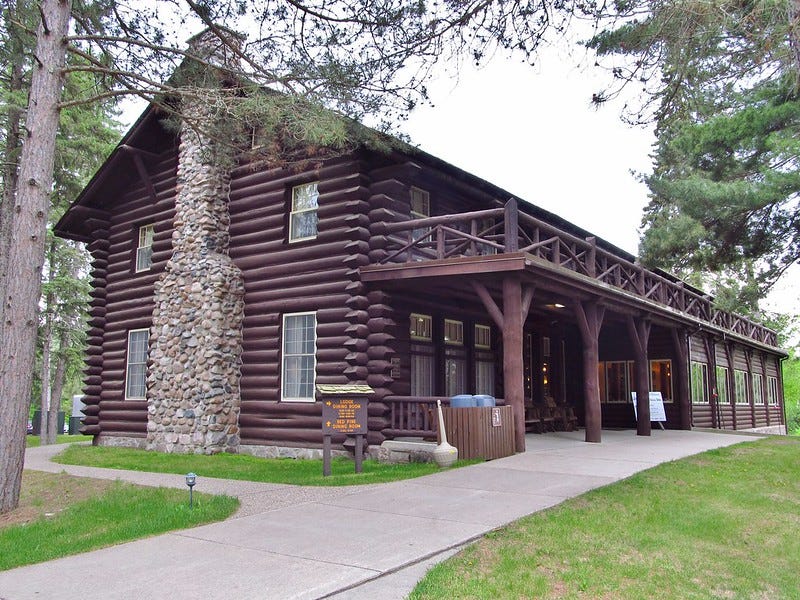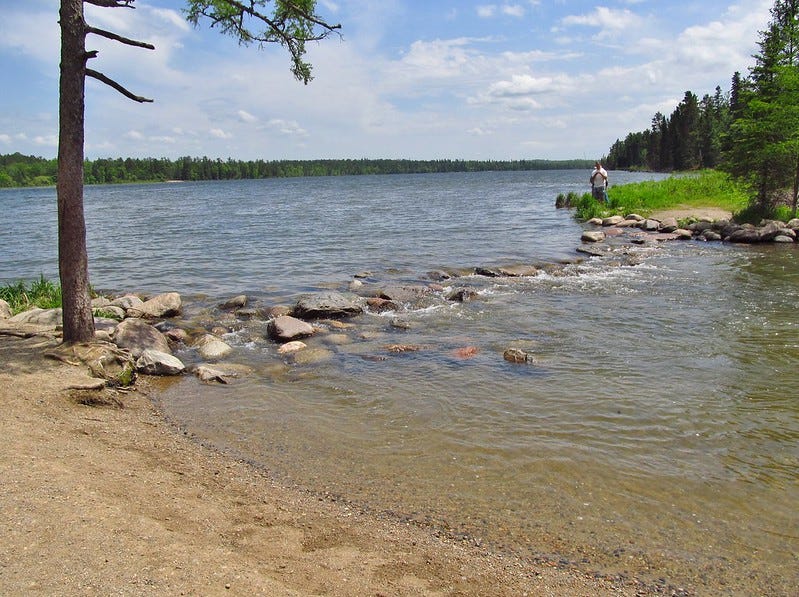Itasca State Park: Where a Veteran Des Moines Travel Editor Goes for Summer Vacation
Christine Riccelli recommends Itasca State Park in Minnesota for that outdoorsy, Northwoods experience—plus a compelling sense of history and some lovely lodgings and good dining, too!
Have you ever tried to do a Minnesota Northwoods vacation? I have, and it didn’t go so well (lots of driving, for not a lot of payoff). The area is so vast, you have to know exactly where to go. Here, veteran travel editor Christine Riccelli carves it out with the precision of a surgeon.

Itasca (Or, How to Do the Minnesota Northwoods)
by Christine Riccelli
My husband and I discovered Minnesota’s Itasca State Park somewhat by accident. It was storming in Brainerd, where we were vacationing, and our then-3-year-old daughter was bored and restless, as were we. So, I looked at a map to find a day-trip destination where it wasn’t pouring and spotted Itasca, some 95 miles northwest of Brainerd (and about 200 miles northwest of the Twin Cities).
Far from being a one-and-done diversion, though, the 32,500-acre natural wonderland quickly captivated us, ultimately becoming one of our favorite getaways that we’ve returned to frequently over the past 20 years. I just recently booked lodgings for this summer as well.
Minnesota’s oldest state park, Itasca was established in 1891 with the eponymous glacial lake at its center. Lake Itasca (plus some 100 smaller lakes), towering old-growth red and white pine forests, an abundance of wildlife, and diverse flora and ecosystems make it a haven for nature lovers, outdoor recreation enthusiasts and those just looking for a calm respite from digital overload and everyday busyness. What’s more, the park is designated as a National Register Historic District; its rich history is evident in the 1905 Douglas Lodge, a number of Civilian Conservation Corps buildings, and other sites, including Native American burial mounds.
Mississippi Headwaters

Itasca’s showstopping attraction, though, is the headwaters of the Mississippi River, which begins its storied 2,552-mile journey to the Gulf of Mexico as a shallow stream emerging from Lake Itasca. In fact, the narrow channel appears much as it did in when Ojibwe guide Ozawindib led geographer Henry Rowe Schoolcraft there in 1832.
As the sun dips, savor the serenity and listen to the haunting call of the loons. Be awed as you ponder the river’s ongoing narrative. You will be enchanted. And humbled.
Start with a visit to the Mary Gibbs Mississippi Headwaters Center to learn more about the iconic river’s history (and to nab an item or two at the gift shop, the best one in the park). From there, take the few-minute walk to the headwaters, kick off your shoes, and get in the water. Walk across the knee-deep, sparkling water to the other side (about 18 feet) or traverse the rocks separating the lake and the river (be careful, as the rocks are slippery). You can then wade down the Mississippi’s first half mile, which flows at a slow 1.2 miles per hour during the summer, according to the National Park Service.
We also like to go at dusk when most visitors are gone; a few times, we were lucky enough to be the only ones there at that time.
Hiking

Itasca has 45 miles of hiking trails, and you can find one that fits your ability (easy and flat or rugged and hilly?), time (15 minutes or a half day?), and mood (lake view or dense forest?). Our favorite is the 2.2-mile Brower Trail, a wooded path along the east arm of Lake Itasca. The trail’s highlight is Preachers’ Grove, named after a convention a group of ministers held there in the early 1900s. Indeed, this tranquil spot invites reflection as you gaze up at the majestic 70- to 100-foot-tall red pines, some of which are 300 years old. A little farther along, Peace Pipe Vista offers one of the park’s prettiest overlooks of the lake. (You also can drive to Preachers’ Grove and Peace Pipe Vista.)
The trail’s highlight is Preachers’ Grove, named after a convention a group of ministers held there in the early 1900s. Indeed, this tranquil spot invites reflection as you gaze up at the majestic 70- to 100-foot-tall red pines, some of which are 300 years old
Another favorite is the Dr. Roberts Trail, a 2-mile loop that starts at the south end of Lake Itasca. The first quarter mile is a boardwalk that crosses through a natural bog; interpretive signs provide fascinating insights about the ecosystem. The path then leads to the Old Timer’s Cabin, a 1934 Civilian Conservation Corps structure built with massive white pine logs. Perhaps the easiest hike is the 1.1-mile Schoolcraft Trail near the headwaters. Wide and flat, it follows the lake’s north arm, providing scenic views of the water.
Bicycling and More
Beyond the headwaters and hiking, there are plenty of other things to do at Itasca. You won’t get bored. Or restless. A few highlights:
· Jacob V. Brower Visitor Center: Located near the south end of the lake, the 13,000-square-foot center provides a useful introduction to the park, with information, exhibits and a gift area, plus an interpretive walking trail behind the facility.
· Main Park Drive and Wilderness Drive: A 16-mile driving loop, the street is two-way for the first six miles, with most of the park’s major attractions along or just off the road. At the north end of the park past the headwaters, the road turns into one-way Wilderness Drive. This portion takes you past old-growth pine stands, including the state’s tallest white pine (110.7 feet), and the more remote trails, lakes and camping areas.
· Bicycling: A six-mile paved bike trail curves through woods and along the lake. You can then continue another 10 miles on Wilderness Drive, though you share that portion with cars. If you don’t feel like hauling your bike to the park, rent one from Itasca Sports; they stock a large supply, including children’s, tandem and electric bikes.
· Swimming and picnicking: Itasca has a sandy beach, and if you go for a swim, be prepared for the water to be refreshing yet bracingly cold. A playground, picnic area, volleyball net, and amphitheater are nearby.
· Boating and fishing: You can rent a pontoon, canoe, kayak, rowboat, or paddleboard from Itasca Sports or bring your own boat. Even in mid-summer, there are few boats on the water; the lack of speedboats and water skiers makes meandering around the lake a relaxing, laid-back experience. Anglers cast for northern pike, walleye, bluegill and largemouth bass.
Where to Stay


Itasca has a mix of lodging, including more than 200 RV and tent campsites, rooms at historic Douglas Lodge, and a variety of cabins at different locations throughout the park. We enjoy staying in the log cabins ($140-$225 per night) near Douglas Lodge. The cabins, which contain one to three bedrooms, have no kitchen (or TVs), though each has an outdoor fire ring and picnic table. The large screened-in porch with splendid lake views and the peaceful beauty and privacy of the wooded setting are the big draws of these cabins.
We’ve also stayed at the nearby Four-Season Suites ($150 per night), which do have a kitchenette in each unit as well as a living room, bedroom with two queen beds, and cable TV. Two six-plex buildings contain the 12 units. There’s no lake view, however.
Where to Eat
This summer, we were disappointed to discover that since the pandemic, the restaurant at Douglas Lodge has drastically cut its hours and menu, going from a daily three-meals-a-day operation to being open only Thursdays through Sundays from 11 a.m. to 5 p.m. with a limited menu. Still, the restaurant’s wild rice soup and fried walleye po boy, classic Minnesota favorites, were flavorful and satisfying, and the lovely view is always a plus. Skip the grab-and-go dining at the Mary Gibbs Café near the headwaters; when we were there, the options were limited and lackluster.
Instead, head to Park Rapids, about 25 minutes south of Itasca. During our July trip, we were so delighted with Good Life that we returned two additional times after our first visit. We especially loved the walleye tacos, wild rice hotdish, and chicken pappardelle. If you’re in town at breakfast time, check out West Forty, a farm-themed family-style restaurant with hearty and solid fare, efficient and friendly service, and budget prices.
If You Go:
Itasca State Park
36750 Main Park Drive
Park Rapids, MN 56470
218-699-7251
While the park is open year-round—it’s also a destination for snow skiing and snowshoeing—most of the park’s lodging, businesses and services go to limited weekend hours after Labor Day and shut down Oct. 1. The Four-Season Suites is the only lodging facility that stays open during the off-season. The Jacob V. Brower Visitor Center also is open year-round.
The Iowa Writers’ Collaborative
I’m proud to be part of the Iowa Writers’ Collaborative, a curated group of independent writers across the state. For an easy way to find out what everyone has written about recently, check out this roundup of last week’s columns.






Christine’s wonderful write up makes me yearn for the Minnesota Northwoods! I’ve enjoyed many summer vacations at Lake Vermillion and Ten Mile Lake. It’s time to plan another trip.
What a thorough and scrumptious look at Itasca Park. Thanks Winnie and Christine! I can’t wait to explore it!